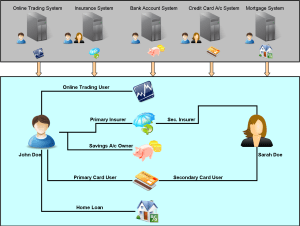
Modeling Financial Industry Services in MDM
Recently I wrote a blog post about implementing master data management system to manage product master data. [Here is the link]. In this blog, I listed some of the unique characteristics of PIM projects taking retail industry examples. I was asked to share my knowledge about how products (or more relevantly – services) are managed in financial industry. Here are my thoughts on this topic.
I had chance to work with several financial customers over past 3 years. Many of these organizations start off their MDM journey with primary objective, and often considered the Holy Grail, to achieve ‘single unified view’ of their customers. They envision MDM system to provide a correct, complete and consistent access to customer data which is otherwise scattered across multiple business units. Banks tend to treat customers as their critical assets as opposed to retail scenario where products are the core assets. They want to reconcile data to identify their unique customers and move out of account-centric systems.
Once functional, MDM hub provides valuable customer information along with customer’s current holdings and positions on each of the financial instruments. This is to ensure that a much deeper insight about customer’s relationship with the bank is achieved. This information can then be used to allow intelligent cross-sell & up-sell. Hence the complete “360 view” is not just about customers but also about the services which the customer is using.
There are multiple ways in which the financial services can be modeled in MDM system. While the representation of services and their linkage to a customer purely depends on the data model offered by the MDM product, there are certain commonalities which we see in every master data expedition.
The above diagram shows how services offered by different business units of the bank to a customer, flow into MDM system. While the existing infrastructure (shown in grey) only show customer’s individual contracts with the company, MDM system (shown in aqua) brings in customer accounts across all business units to deliver full 360 degree view of customer. In this depiction, John Doe and Sarah Doe use multiple services offered by the bank. The bank account opened by John has a credit card service, trading account and insurance attached to it. He also has a home loan from bank where his wife Sarah is a co-applicant. They both have life insurance coverage from the bank where Sarah is beneficiary.
Since we would like to flow different types of services offered by the bank to the MDM system, service modeling in MDM can get really complex. However, there is some good news to it. Unlike customer data, we do not want each and every detail of service products to get reflected in MDM. These services are managed in their respective sources and continue to be owned by them. However, some of the basic information about these services needs to be accommodated so as to know customers better. We call this type of accounts in MDM as referenced accounts. Meaning, they are being referenced by MDM, but they continue to be managed and owned by respective source systems.
Below are some of the guidelines I follow while modeling services in MDM.
- It’s critical to determine which service attributes add value. While data mapping activity, scrutinize an attribute by asking the question – Will this attribute help me in recognizing how valuable this customer is for the bank?
- Attributes like Risk Score, Credit History of the customer, Total Yearly Revenue (for Organization type of customers), and Account Open Date are some of the important attributes which needs to be considered. These attributes allow banks to accurately measure risk exposure.
- Accommodate account to account relationships. Example- the insurance incentive provided along with gold card, mortgage and free checking bundle etc.
- The role played by the customer on an account, different billing addresses he is using for a given contract should be captured.
- An attribute which changes its value many times a day (Ex: Savings bank balance, Payments via Credit card) will not constitute master. These attribute are not only difficult to manage, but also add significant performance overhead to the system.
In a financial scenario, customer is core entity and needs to be managed efficiently. Centralization of customer information allows us to manage this customer efficiently in one place by taking control of data quality, standardization and duplicate removal. Also, MDM makes this data available seamlessly across the enterprise via a standard like SOA. I would try to keep only key information about services and contracts by following above guidelines. This allows us to concentrate on efficiently managing customer data which is the true asset of a financial organization.
What do you think about financial service modeling? What additional aspects can you think of? Do share your thoughts via comments.
COMMENTS
Leave A Comment
RECENT POSTS

Composable Applications Explained: What They Are and Why They Matter
Composable applications are customized solutions created using modular services as the building blocks. Like how...

Is ChatGPT a Preview to the Future of Astounding AI Innovations?
By now, you’ve probably heard about ChatGPT. If you haven’t kept up all the latest...

How MDM Can Help Find Jobs, Provide Better Care, and Deliver Unique Shopping Experiences
Industrial data is doubling roughly every two years. In 2021, industries created, captured, copied, and...
As in the modern technology of world we all know the whole global economy of the world depends upon the two main pillars banking and financial sector. As with this solution these industries are more productive and with banking sector you can open your bank account at home. As various facilities like bank account details, cash details etc we get through SMS. If we talk about past few years then the whole business had been done on papers but now with this MDM solution these industries has been transformed.